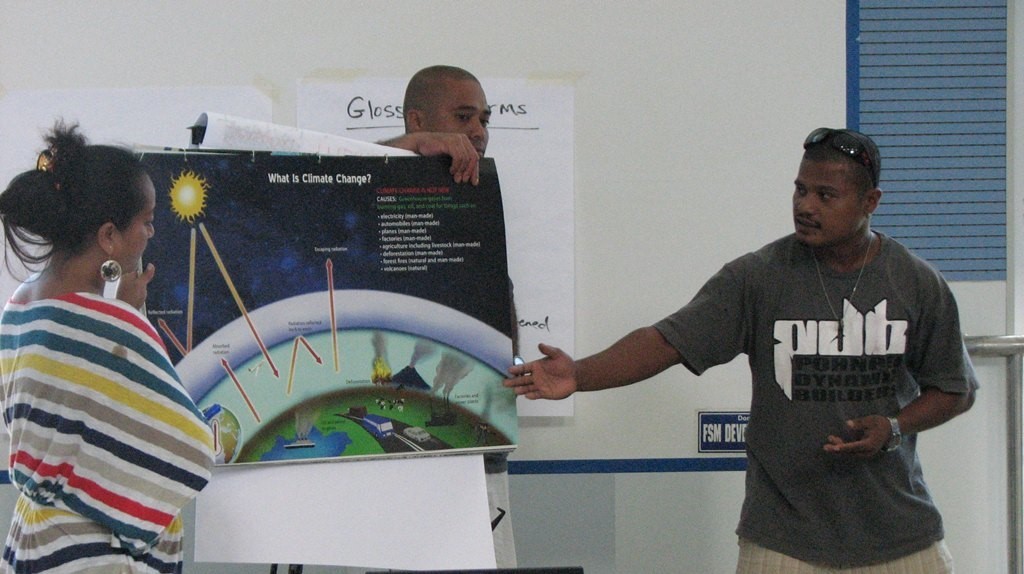Communicating Climate Change
Coral reef managers may be faced with difficult discussions about climate change. Having tools to communicate about it effectively is key to broadening awareness and encouraging much needed action.
Over the last several decades, many studies have explored how to more effectively communicate about climate change. Two of the most important recommendations are: 1) know your audience; and 2) engage your audience (don’t lecture, listen to what they care about and talk about climate change in the context of what matters to them). Simple messages, repeated often, by trusted messengers are powerful. ref

Climate change communication materials presented by staff from the Conservation Society of Pohnpei. Photo © Meghan Gombos
Key Talking Points
In addition to key talking points on climate change, marine managers are also recognizing the power of developing participatory videos to capture local perspectives on climate change impacts and responses.
Basic Principles of Communicating about Climate Change ref
- Know your audience (e.g., their values, work, concerns). If you can connect what your audience cares about to climate change, they are more likely to listen.
- Connect on common values. Many people start the conversation by talking about the science of climate change (i.e., causes and consequences). However, if you want people to care and act, you need to make the issue relevant to them. To do so, start by connecting to the values that bring people together (e.g., family, health, community)
- Scale from personal to planet. People understand what they can see around them. Talk about the climate/hazard impacts they can see (e.g., typhoons, coral bleaching), then scale up to other areas of the country or the planet. Starting with global catastrophe leads to fatalism, since many people can’t see how their actions could address such a big problem.
- Use words people can understand. A lot of climate change terms, like “mitigation,” don’t mean much to people. Instead, use words such as prepare or preparedness. Rather than talk about “alternative energy,” talk about wind and solar power. Rather than “ecosystem collapse”, talk about the plants and animals that we depend on to survive. The most persuasive language is vivid, familiar, and descriptive.
- Inspire and empower. The most important thing to do to get people to engage on climate change is to convey a sense of hope and potential. Provide concrete examples of actions and solutions; provide more solutions than problems.

A film about local climate change solutions by students in Samoa was showcased in the Action4Climate International film competition. Photo © Action Against Climate Change
- Have at least 1 powerful fact from a trusted messenger. One or two facts with a lot of emotional power can add significant weight to your message. Highly trusted messengers - different for different audiences - lend credibility and importance. Find a great, relevant quote from someone your audience knows and trusts.
- Prepare, don’t adapt. Adaptation is a disempowering term that leads to fatalism and resignation. You can’t do anything about it, so just adapt. Preparation, on the other hand, leads to action. Preparation implies there’s a problem that we can do something about.
- Shift from “uncertainty” to “risk”. Most people are used to dealing with the idea of risk. It is the language of the insurance, health and national security sectors. So for many audiences (e.g., politicians, business leaders) talking about the risks of climate change is more effective than talking about the uncertainties of climate change.
- Communicate through images and stories. Most people understand the world through stories and images, not lists of numbers, probability statements or graphs, and so it is crucial to find ways of translating and interpreting the technical language in scientific reports into something more engaging.
The following is an example of a short statement that includes several of the principles above:
The world’s reefs are critically important to people; they provide coastal protection, food (fisheries), tourism income, medicines, and often hold spiritual and cultural importance. Reefs are threatened by climate change and other human impacts. But there’s something we can do about it. The future lies in our hands. Effective coral reef management that considers climate change will help to protect coral reefs and secure the benefits they provide.
